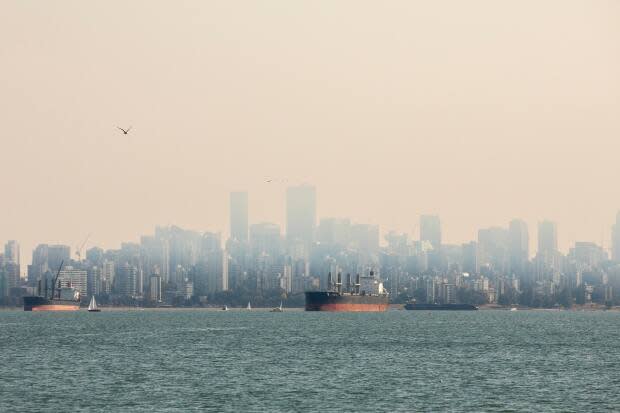Metro Vancouver could soon see smoky skies, experts warn

The Lower Mainland might see smoky skies soon as wildfires continue to burn across B.C. and continental America, scientists are warning.
Metro Vancouver has thus far escaped the brunt of the hazy conditions that have caused air quality warnings to be issued throughout the province.
However, as nearly 300 wildfires continue to burn in B.C. and in the northwestern U.S., meteorologists and environmental scientists are saying the region might not have clear conditions for too much longer.
The reason the South Coast has not yet faced air quality warnings is because of where fires are burning, according to provincial air quality meteorologist Tarek Ayache.
"Given that the fires are mostly in the Interior and south of the border, and given that the wind is blowing mostly from the southwest, [...] the smoke is mainly affecting the Interior and not the coast," he said.
Ayache says the situation is "volatile", however, and new wildfires or a change of wind conditions could mean hazy conditions on the South Coast very quickly.
The region's long dry spell, with no rain on the horizon for a while, means fires could start "at any time," according to Ayache.
Interior air currently very unsafe
Michael Mehta, an environmental studies professor at Thompson Rivers University, says air quality in the Interior is "way beyond safe levels."
"We know that from the California wildfires in recent years, with numbers [of pollutants] that are a lot less than what we've seen in British Columbia this year [...] that we're likely to have a proportionately higher number of excess deaths," he said.
Mehta says the readings for particulate matter in Kamloops, based on sensors he set up, show concentrations of particulate matter well beyond 100 micrograms per cubic metre.

The World Health Organization says that a value of 25 micrograms per cubic metre over a 24-hour period is considered safe, while the province aims for a value of eight yearly.
However, the fact that these smoky conditions are concentrated away from the South Coast is what is leading to political inaction, according to Mehta.
"I think that's one of the reasons why Premier John Horgan hasn't called for a provincial state of emergency, which he should. I mean, a lot of the province is on fire," Mehta said.
The air quality health index in Kamloops has sat at 10+ (very high health risk) for much of the week, while it only peaked at three at Metro Vancouver's recording stations.
"It just takes the energy out of you, and it's hard to breathe. So you don't want to be moving too fast," said Kamloops resident Nancy Bepple, describing what she says are "abysmal" conditions.
She says the smoke was so dense in the city this week she was unable to see across the Fraser Valley.
Ayache says he encourages residents in the South Coast to prepare for smoky conditions by subscribing to the province's air quality advisories so that they are informed of poor air quality in their area.

